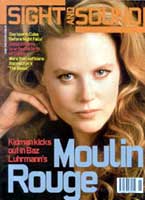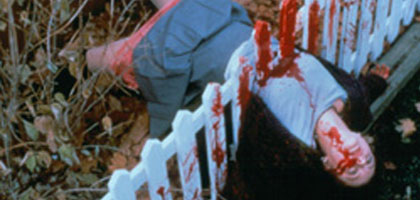
Blood sisters
Film of the Month: Ginger Snaps

Ginger Snaps links entry to womanhood with bloodlust and violence. Linda Ruth Williams explores its mixed metaphors
Try to imagine what Buffy the Vampire Slayer would look like if it had been written by Angela Carter and you might get close to the heady cocktail of high-school pubescence and feminist folklore that is Ginger Snaps. This is the story of 16-year-old Ginger (Katharine Isabelle) and 15-year-old Brigitte (Emily Perkins), two repressed, weird, goth-styled sisters whose bland Canadian suburb happens to be plagued by a werewolf. Ginger Snaps is a sparky, sharp film marked by intelligent dialogue and a complex view of that moment when girls hover on the brink of womanhood but would rather not take the next step. If Carter's Red Riding Hood fell for her wolf and ran off with him in Neil Jordan's Company of Wolves, here the bitten girl becomes the wolf. Ginger is attacked on the night she first menstruates, and as the clock of her cycle ticks away to its conclusion on Halloween 28 days later, she metamorphoses into a sinewy, sexualised monster with a nice line in teenage sarcasm.
Ginger Snaps - directed by John Fawcett, whose previous work includes episodes of Xena Warrior Princess, and written by Karen Walton - is a radical film in a number of ways, not least in its twist on the economies of punishment that haunt the horror genre. Teen horror pivots on the motif of the sexualised couple punished for their fornication (memorably expounded in such films as Halloween, 1978, and Friday the 13th, 1980; remorselessly parodied in the Scream series), and at first Ginger Snaps appears to promote this viewpoint by violating its virgin heroine/monster at the instant her sexual/reproductive functions kick in, suggesting that simply to cross the threshold to womanhood is sufficient to bring the hellhounds to your door. Yet the consequences of feminisation are not so simple. Ginger Snaps' sister heroines are essentially female Peter Pans who have contrived to delay the onset of menstruation for years, masking their terror of adulthood with a performance of supreme adolescent alienation. And who can blame them for not wanting to join the ranks of women? From the school nurse who chirpily explains just what the fertile future holds and the huge wall of sanitary products that confronts the girls at the supermarket to the kooky mother (brilliantly played by Mimi Rogers) who announces to all present at the family dinner table that'Our little girl's a young woman now' while producing a luridly red celebratory strawberry cake, the choices on offer are hilariously horrifying.
But Ginger Snaps also glories in the notion that being a woman is in itself such a crime, one might as well be hanged for a sheep as for a lamb. In one memorable scene in the girls' toilets, Brigitte insists to her sister:'Something's wrong - like, more than you being just female.' If Ginger's new-found femininity has already 'cursed' her to a life of blood-stained knickers (which Mom finds lurking in the dirty laundry), she might as well immerse herself in a riot of bloodlust and have done with it.'Can this happen to a normal woman?' a kitsch television commercial queries early in the film. To which the answer - for Ginger at least - is a resounding,'Yes, precisely because she's a normal woman.'
Yet there are also things one can neither help nor control, the film seems to say. As the pet-dog corpses that litter Ginger Snaps' suburbs remind us, the beast is non-judgmental in his (or her) violence. As in Jaws, this is a film in which everyone is potentially meat. One can glory in it or be a victim to it, and Ginger prefers to glory ('I get this ache,' she says,'and I thought it was for sex, but it's to tear everything into fucking pieces'). Here femininity is a precondition of violence, and violence offers Ginger an alternative to the sexual stereotyping that surrounds her. ('No one ever thinks chicks do shit like this. A girl can only be a slut, a bitch, a tease, or the virgin next door.') An audacious thought indeed for a genre traditionally driven by the testosterone of male adolescence.
But even before the werewolf strikes, Ginger and Brigitte are no ordinary high-school babes. While their contemporaries are going all the way with their boyfriends, these girls prefer the pastime of staging and photographing elaborately grotesque suicide scenes. Part of the film's fun comes from its ability to take a range of grand metaphysical concepts - especially those two great pillars of philosophy and psychoanalysis, sex and death - and run them through the filter of the suburban teenage female mind. What comes out may not be pleasant (the film is visceral and gory), but at least it's interesting.
Ginger Snaps is haunted by stories of high-school massacres (notably Taber and from across the border Columbine) which makes its glorious take on a schoolgirl gone (literally) wild a sensitive subject. The film also nods to contemporary notions of sexual morality in its casting of werewolfism as a blood-borne disease that can be caught through the 'consumption' of carnality. Where the early-90s spate of vampirism-as-Aids narratives figured 'haemosexuality' as a metaphor for STDs (mirroring Bram Stoker's syphilis in the 1890s), here it's werewolfism that's sexually transmitted. As Ginger's external conscience, Brigitte reminds her that violation of the safer-sex code has its consequences:'You gave it to Jason - you had unprotected sex and you infected him!' But this is just the starting point for a meditation on the biology that defines the condition. Proposing a rational solution to an irrational malaise, the film's Van Helsing figure, drug dealer Sam, retorts,'Biology! Now there's something you can sink your teeth into... You're real, your problem's real, the solution's real.' Here Walton's screenplay echoes David Cronenberg in its reference to lycanthropy being'like an infection, it works from the inside out. It's like a virus.' But if Cronenberg plumps for a poetics of the flesh that finally celebrates the'world turned upside down' of bodily rule, Ginger Snaps refuses to choose. It's a testament to these two young actors' performances that Brigitte's monster-hunting control and Ginger's monstrous derangement are equally sympathetic and alienated.
The arc of the film owes much to John Landis' An American Werewolf in London - in particular its buddy story and bleak conclusion which posits that the beast has no sentiment, no room for love and no memory of loved ones. But the questions of identity lost, found, then lost again go further in Ginger Snaps. Though the relationship between Ginger and Brigitte is akin to that between twins, the age gap between them pitches them on either side of the pubescent divide. Cinematic twins are often figured as dark and light reflections of each other (from Robert Siodmak's classic The Dark Mirror, 1946, to Gregory Hippolyte's kitsch Mirror Images, 1991), but the properties of sameness and difference Ginger and Brigitte manifest make them more like Alice and her looking-glass reflection.
When Brigitte deliberately infects herself with Ginger's malaise, she declares,'Now I am you.' To which Ginger replies,'I know you are, but what am I?' It's a good question. The 28 days the story tracks show Ginger hovering between a number of identities - human and beast, victim and violator, virgin and whore. All do service to describe the anxious moment of adolescence many a great horror film has tried to articulate (The Exorcist, 1973; Carrie, 1976) - but seldom with such a strong interest in the point of view of the girl herself. US critic Carol J. Clover once wrote that in our dreams we straddle the divide between monster and victim:'We are both Red Riding Hood and the Wolf.' Ginger is a girl who walked in the woods and came back as the wolf disguised as a teenage virgin, a wolf in girl's clothing.
